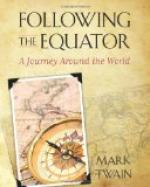the headquarters of the Brahmin faith, and one-eighth
of the population are priests of that church.
But it is not an overstock, for they have all India
as a prey. All India flocks thither on pilgrimage,
and pours its savings into the pockets of the priests
in a generous stream, which never fails. A priest
with a good stand on the shore of the Ganges is much
better off than the sweeper of the best crossing in
London. A good stand is worth a world of money.
The holy proprietor of it sits under his grand spectacular
umbrella and blesses people all his life, and collects
his commission, and grows fat and rich; and the stand
passes from father to son, down and down and down through
the ages, and remains a permanent and lucrative estate
in the family. As Mr. Parker suggests, it can
become a subject of dispute, at one time or another,
and then the matter will be settled, not by prayer
and fasting and consultations with Vishnu, but by
the intervention of a much more puissant power—an
English court. In Bombay I was told by an American
missionary that in India there are 640 Protestant missionaries
at work. At first it seemed an immense force,
but of course that was a thoughtless idea. One
missionary to 500,000 natives—no, that is
not a force; it is the reverse of it; 640 marching
against an intrenched camp of 300,000,000—the
odds are too great. A force of 640 in Benares
alone would have its hands over-full with 8,000 Brahmin
priests for adversary. Missionaries need to be
well equipped with hope and confidence, and this equipment
they seem to have always had in all parts of the world.
Mr. Parker has it. It enables him to get a
favorable outlook out of statistics which might add
up differently with other mathematicians. For
instance:
“During the past few years competent observers
declare that the number of pilgrims to Benares has
increased.”
And then he adds up this fact and gets this conclusion:
“But the revival, if so it may be called, has
in it the marks of death. It is a spasmodic struggle
before dissolution.”
In this world we have seen the Roman Catholic power
dying, upon these same terms, for many centuries.
Many a time we have gotten all ready for the funeral
and found it postponed again, on account of the weather
or something. Taught by experience, we ought
not to put on our things for this Brahminical one
till we see the procession move. Apparently one
of the most uncertain things in the world is the funeral
of a religion.
I should have been glad to acquire some sort of idea
of Hindoo theology, but the difficulties were too
great, the matter was too intricate. Even the
mere A, B, C of it is baffling.
There is a trinity—Brahma, Shiva, and Vishnu—independent
powers, apparently, though one cannot feel quite sure
of that, because in one of the temples there is an
image where an attempt has been made to concentrate
the three in one person. The three have other
names and plenty of them, and this makes confusion
in one’s mind. The three have wives and
the wives have several names, and this increases the
confusion. There are children, the children have
many names, and thus the confusion goes on and on.
It is not worth while to try to get any grip upon
the cloud of minor gods, there are too many of them.




